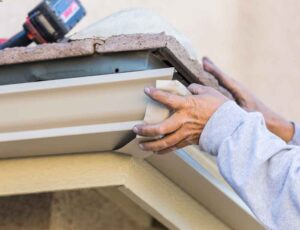Keeping up with routine maintenance and regularly inspecting your roof can help you keep your roof in good condition for a long time. But even the most diligent homeowner may need to replace their roof eventually. Asphalt shingles, for example, tend to last an average of 12.5 years, per the Metal Roofing Alliance. As your roof ages and the need for repairs becomes constant, you may want to consider a roof replacement.
Once you determine it’s time for a new roof, your next decision is choosing the season you’ll schedule your roof replacement. While you may be able to replace your roof at any time of the year, some seasons tend to be better than others due to temperature and weather conditions.
When Is the Best Time to Replace a Roof?
The best time of year to replace a roof is typically fall. However, there are pros and cons to all four seasons.
Pros and Cons of Fall
Roof replacement in the fall is often the ideal situation. The pros of replacing your roof during autumn include:
- Temperate weather: Fall tends to have the best weather conditions for roof replacement. Temperatures are cooler and more stable in the fall than in the summer and warmer than in winter. This temperate weather is ideal for installing all types of roofing before the extreme winter weather hits.
- Winter preparation: You can prepare your home for the winter by scheduling your roof installation in the fall.
- Faster job completion: Average roof replacement times are faster in the fall. Workers can complete the job faster because of the temperate weather, which allows roofers to spend more hours of the day working.
There’s one disadvantage of scheduling your roof replacement for the fall — this time of the year tends to be one of the busiest. Other homeowners use the fall to prepare their homes for winter, so contractors often have a packed schedule. If you schedule your replacement too late, available slots in a contractor’s schedule may be limited, and the price may rise due to the increased demand.
Pros and Cons of Spring
Many homeowners first notice problems with their roofs during the spring season. Harsh winter weather can lead to damage and leaks in your roof, and once the snow melts, it’s easier to spot these problem areas. Roof replacement in the spring can be another good option, though it comes with a few more cons than fall. The pros of replacing your roof in the spring include:
- Warmer temperatures: Similar to fall, spring temperatures are ideal for a roof installation job. The temperature is starting to warm, but it hasn’t grown to the extreme heat of summer. This means roofing crews will work more efficiently, and roofing materials are applied in ideal conditions.
- Comfortable working conditions: Due to the temperate weather, working conditions are more pleasant, so workers are likely to work more quickly and require fewer breaks.
However, spring also tends to come with more unpredictable weather than the fall. Many regions experience long periods of rain in the spring, and some regions even continue to experience snow. This could lead to a lengthier installation process. Another disadvantage of a spring install is thermal shock, which is an effect caused by large temperature swings in a short period of time. Thermal shock affects single-ply and shingle systems, as shingles may not seal correctly, or the seal may be broken. Single-ply can expand and shrink, breaking open seams and flashings.
Pros and Cons of Summer
While roof installations are popular in the summer, they also tend to be more unpredictable. Some of the cons of installing your roof in the summer include:
- Extreme heat: In the summer, the sun shines bright, and temperatures are high. Shingles can be less durable, as they aren’t meant to set in extreme heat.
- Scheduling difficulties: Since summer is a popular time for roof installations, getting on a contractor’s schedule can be difficult. A roof replacement in the summer generally requires some planning ahead.
- Uncomfortable working conditions: Along with high temperatures, the weather can also be very humid, making for uncomfortable working conditions. Workers may need more breaks, which makes the job a longer process.
One of the pros of a roof installation in summer, however, is that days are longer. This will give workers more time in the daylight to complete the job. Compared to spring, there also tends to be less rainfall. If you need to schedule your roof replacement in the summer, aim to do so in the earlier summer months to avoid the extreme heat and humidity.
Pros and Cons of Winter
A roof replacement in winter typically isn’t ideal due to the extreme weather conditions. Depending on the roof type you select, the disadvantages of replacing your roof in the winter include:
- Cold temperatures: Winter can come with frigid temperatures. Many roofing tools are less effective in cold temperatures, and roofing materials can turn brittle and hard.
- Harsh conditions: Weather can be severe in the winter. Ice, sleet and snow can make work conditions difficult.
- Slower job completion: Due to the cold temperatures and harsh conditions, workers are likely to need more breaks, and their work may be more frequently disrupted.
Winter doesn’t present any challenges in the installation of metal roofing other than delays caused by snow or ice accumulation. Overall, the best time to replace your roof is when you need it. If your roof is old, damaged or presents a risk to you and your family, schedule your roof replacement as soon as possible with Cornett Roofing Systems.
When Is the Slow Season for Roofing?
Winter is usually considered the slow season for roofing. This is due to the extreme weather and difficult working conditions. However, the slow season may actually be an advantage to you. In the winter, availability among contractors increases and prices tend to drop. If you’re looking to make the job as affordable as possible and you don’t want to worry about getting on a contractor’s schedule during the busy seasons, winter could be a good time of the year for your roof installation.
Contact Us for Roofing as Durable as It Is Beautiful
If you are a homeowner looking to replace your roof, turn to Cornett Roofing Systems. We manufacture and install a premium metal roofing system that is made in our plant in central Indiana. We are committed to advocating for and installing permanent and sustainable roofing products rather than disposable and environmentally damaging asphalt shingles. We view ourselves as craftsmen and fabricators, highly experienced in working with old-world roofing styles such as slate, tile and wood shake.
Whether you want a metal roof, a clay tile roof or a slate roof for your home, we have the right option for you. Contact us at Cornett Roofing Systems to get a free estimate for the last roof you’ll ever buy.





